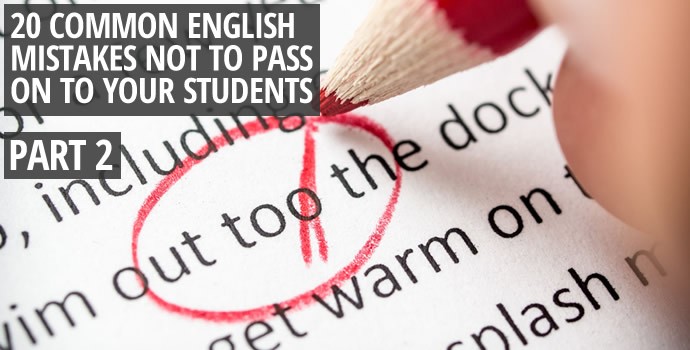In July 2015 we published a blog post about 20 Common English Grammar Mistakes Not to Pass on to Your Students. The post provoked substantial discussion about the correct usage of many of the terms that it highlighted. Here are 20 more common errors to avoid passing on to your students:
1. Yet/already
In colloquial American English using yet and already with the past simple tense is common and widely accepted. It should, however, be combined with the present perfect tense.
Incorrect usage: I already went or you didn’t eat yet
Correct usage: I have already gone or you haven’t eaten yet
This may appear like nit-picking, but the textbook that you will use in the classroom is likely to say the same thing, and you do not want the students to catch you making this error.
2. Like
Excessive use of the word like adds nothing to our speech, and can sometimes obscure meaning.
Used in a sentence: this is, like, a great movie
Adding like to the above sentence changes its meaning. Instead of saying that it is a good movie, you are saying that it is similar to a good movie.
3. Could care less
You should not confuse the expressions could care less and couldn’t care less
Incorrect usage: I could care less about it. It is of no importance to me
Correct usage: I couldn’t care less about it. It is of no importance to me
In this context it makes no sense to say that you could care less because you want to say that you do not care at all. Of course, in certain circumstances you can use could care less, but only if it is possible that you care less than you do now.
4. Less instead of fewer
Often native speakers use less when they should use fewer.
Incorrect usage: there are less people here than yesterday
Correct usage: there are fewer people here than yesterday
We should use fewer when we talk about countable nouns; these are nouns that we can count. As we can count people, we should use fewer in the above sentence and not less. We can use less with non-countable nouns, such as air, water and politics.
5. Principal/principle
A principle is one of a set of core values.
Used in a sentence: kindness is one of my guiding principles
Principal, on the other hand, has two meanings. The first is that of a head or a leader. This is a noun.
Used in a sentence: the principal at my high school was very strict
To confuse things further, principal is also an adjective. It means the first or the most important.
Used in a sentence: his principal concern was about the noise
6. Apostrophes
Apostrophes can change the meaning of a sentence significantly.
Incorrect usage: there are 250 girls here. The girl’s bedrooms are on the right
Correct usage: there are 250 girls here. The girls’ bedrooms are on the right
We use ’s to indicate that a single person or object possesses one or more other objects. In the first example above, all of the bedrooms belong to one girl. In the second example the s’ indicates that the bedrooms belong to the group of girls.
7. –ise or -ice
Some nouns and verbs are spelt and pronounced differently to distinguish between the verb and the noun form. In these cases, the words ending in ‘-ise’ are verbs and the words ending in ‘-ice’ are nouns. Here are two common examples to watch out for:
Advise (v.) vs. advice (n.)
Used in a sentence: she advised me, but her advice was bad
Devise (v.) vs. device (n.)
Used in a sentence: it took them years to devise a suitable device
8. Which or that
We use that with identifying adjective clauses.
Incorrect usage: I like the car which has blue stripes
Correct usage: I like the car that has blue stripes
Here the relative clause – ‘has blue stripes’ – helps us to identify the object of the main clause (car). Which car? The car with blue stripes. The relative clause, therefore, is identifying and we must use that. Note that we do not use a comma before that.
We use which with non-identifying adjective clauses.
Incorrect usage: we visited New York, that is a big city
Correct usage: we visited New York, which is a big city
Here the relative clause – ‘is a big city’ – does not help to identify the object of the main clause (New York). In this case, the clause merely adds extra information. The relative clause, therefore, is non-identifying and we must use which. With which it is necessary to use a comma.
9. Negatives
We cannot use double negatives in English.
Incorrect usage: I don’t know nobody
Correct usage: I don’t know anybody
10. I.e. or e.g.
I.e. and e.g. are two common Latin abbreviations in English. E.g. equates to ‘for example’.
Used in a sentence: there are many types of fruit, e.g. apples
I.e has an entirely different meaning. It means ‘in other words’.
Used in a sentence: I visited the Big Apple, i.e. New York
11. When to use a Semi-colon
Semi-colons are used to show a link between two standalone clauses.
Used in a sentence: I felt sick; I had just woken up
Here the semi-colon is used to indicate a connection between the two clauses. Without a semi-colon they are two facts that may or may not be linked. Semi-colons can also be used to break up more complicated lists.
12. Uninterested or disinterested
Uninterested is similar in meaning to bored.
Used in a sentence: I was uninterested in the drab painting
Disinterested is similar in meaning to impartial.
Used in a sentence: a referee should be disinterested in the game
13. Inflammable
Inflammable has the same meaning as highly flammable, and does not mean that something will not burn easily.
Incorrect usage: it is ok by the fire, the label says its is inflammable
Correct usage: don’t put it near the fire, the label says it is inflammable
14. Conjunctions at the start of a sentence
Conjunctions connect ideas. We should not, therefore, use conjunctions such as and, but and or to start a sentence.
Incorrect usage: we met up with him. And then we drank a beer
Correct usage: we met up with him, and then we drank a beer
15. Its or it’s
Its is a possessive pronoun much like his or her.
Incorrect usage: it’s interior is clean
Correct usage: its interior is clean
It’s is a contraction of ‘it is’ or ‘it has’. It’s is never possessive.
Incorrect usage: its a really nice day
Correct usage: it’s a really nice day
16. Yourself instead of you
Yourself is not a more formal version of you. You is a subject or object pronoun. Yourself is a reflexive pronoun.
Incorrect usage: I have not spoken to yourself before
Correct usage: you are looking at yourself in the mirror
You can use yourself if the subject and the object of the sentence are the same person, as in the second example. If the subject and the object are different people then it is not possible to use yourself.
17. Your or you’re
Your and you’re are pronounced in the same way, which is why they sometimes cause confusion.
Incorrect usage: your a little rascal, and so is you’re brother
Correct usage: you’re a little rascal, and so is your brother
Your is a possessive pronoun and is always combined with a noun. In the above example it is combined with the noun ‘rascal’. You’re is a contraction of ‘you are’.
18. Was or were
When we use the second conditional in English we should use were instead of was in all cases.
Incorrect usage: if I was older, I could drink alcohol
Correct usage: if I were older, I could drink alcohol
This is also true of the structure ‘I wish + past simple’
Incorrect usage: I wish I was a superstar
Correct usage: I wish I were a superstar
19. Dangling participle
Dangling participles can confuse the meaning of a sentence.
Used in a sentence: visiting relatives can be tedious
It is not clear what the subject of the sentence is. It could be ‘relatives’ or ‘visiting relatives’.
20. Comparatives
Be careful when using the comparatives.
Incorrect usage: the red one is more easy than the green one
Correct usage: the red one is easier than the green one
There are a number of rules that govern the use of comparatives. In general, if the adjective is one syllable, add ‘-er’ to the end of the adjective (e.g., taller). If it is two or more syllables, add more or less before the adjective (e.g., more difficult). If the adjective is two syllables and ends in ‘y’, add ‘-ier’ (e.g., fluffier).
Many new and prospective teachers worry about understanding and using the correct grammar rules. Fortunately, a TESOL/TESL/TEFL Certification combined with proper practice will help you learn grammar rules and catch mistakes before passing them on to your students.
In case you missed it, check out 20 Common English Grammar Mistakes Not to Pass on to Your Students (Part 1).
Ready to start your adventure teaching English abroad?
Download our free course guide
Sign up for a free information session
Find a course near you
Written by: Robin Garnham
Robin Garnham originally planned to spend a year teaching in Spain to improve his Spanish, but has now been teaching for five years. He currently teaches ESL in Oakland, California and is an Oxford Seminars instructor in San Jose, California.



 Oxford Seminars Blog
Oxford Seminars Blog 









Inflamable— is this word equivalent to flammable?